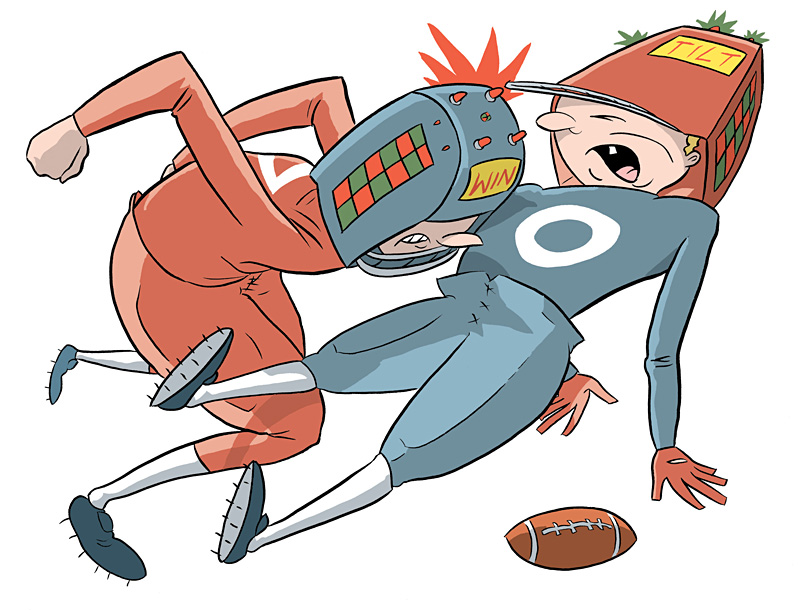For a few humble contract laborers in Seattle, Christmas came early this year. That’s because Amazon.com decided to start selling toys. On July 13, the company launched its new Toys and Games store. In the weeks leading up to the launch, and in the months since, the company needed product “reviews” to accompany each of the thousands of toys and games for sale on the site. The result has been a bonanza—both lucrative and mind-numbing—for a small community of local writers.
All over Seattle in the last six months, highly literate adults could be found in their studio apartments, surrounded by Little Smart Tip ‘n’ Stack Turtles, Rokenbok System Basic Start Power Chutes, Frog Bath Mitt Puppets, and Barbie Knit Hit Fashion Makers . . . and struggling to come up with something to say about them.
These freelance wordsmiths make their living off the high-tech world’s relentless, yet ever-changing, hunger for “content” (otherwise known as words and sentences): First it was CD-ROMs; then Web zines and online city “guides,” like the defunct Microsoft Sidewalk; now it’s catalog copy for e-commerce that’s in top demand.
While Amazon promised its customers “in-depth reviews from [our] own staff of toy experts,” the “experts” themselves find this description a little fanciful. “They seemed desperate to get anyone, they really did,” says one Amazon contractor, a young woman we’ll call Miss Match Box. (All of the Amazon contributors are sworn to secrecy via their “Non-disclosure agreements.”) “I had a little hesitation when they approached me. What do I know about toys?” But at $40 a pop—for just a few lines of toy verbiage—the gig was hard to pass up.
Those who signed on soon took delivery of a giant box at their homes. “It was all on the q.t., of course,” says an Amazon contributor whom we’ll call Millennium Princess Barbie. “The delivery guy said to me, ‘Say, what’s in the box?’ and I said, ‘Mmm, I dunno,’ and he said, ‘That’s funny, I’ve been delivering toys all day.'” (Obviously someone with insider contacts.)
Each week, over the next several months, these writers would come home to a giant box of mystery toys sitting on their porch, which they would proceed to unpack—as many as 50 toys at a time. “There would be this heap of plastic and junk [in the house] because of the way small toys are packaged,” says a writer we’ll call Charmander #4. “There was an extraordinary amount of garbage.”
And at week’s end, all that garbage, and the toys, had to be shoved back in the box and set out for retrieval by the delivery man. For some reason, “Amazon wanted all the stuff sent back to them,” says Charmander #4. So even though #4 has a young child, he had to keep the toys hidden from her in a back room. “I didn’t want her to get attached to anything,” he says. And no testing out the Chuck E. Cheese Pizza Factory to see if it really works!
Since Amazon first began as an Internet bookseller, the company has managed to establish a rather blurry line between what you might call “independent editorial judgment” and outright marketing hype. But the suits running Toys and Games made that line a little less blurry: “They didn’t seem real open to negative reviews,” notes Match Box. Says Millennium Princess Barbie: “With toys—unlike books—there’s an assumption it will receive a positive recommendation.”
The company provided a list of “educational objectives”—such as improved motor skills, memory, deductive reasoning, etc.—and encouraged the writers to link the toy to one of those objectives whenever possible. “They were reasonable about it,” says Charmander #4. “They didn’t say we had to. But we were supposed to talk the stuff up.”
Positive reviews did not come without risk, either. That’s because Amazon put all the legal liability on the writer, not on the company. “So if I give a positive review to a toy and the parent orders it, and then something happens [such as an accident or an injury], Amazon is blameless and I can get sued,” says Charmander #4. “I tried to incorporate subtle warnings.”
Even with that guidance, toy reviewing challenged these writers like nothing before. “I’d be looking at one of these no-purpose gelatinous balls with hunks of plastic floating around in it, made in some sweatshop in Singapore, and think: ‘what am I supposed to say about this?'” recalls Charmander #4. “Sometimes my approach was, ‘let’s see what it would take to break this.'”
“My first box had about 30 stuffed animals,” says Millennium Princess Barbie. “My thesaurus is pretty dog-eared. But the stuffed animals were nothing compared to Nascar. Nascar was just crippling. To be given eight different models of the same car and come up with eight different descriptions . . .”
As the shipments arrived each week, Millennium Princess began to wonder why Amazon needed a $40 write-up for every one of the hundreds of trivial items. “It was an amazing waste of manpower,” she says. “You’d get these clothes for G.I. Joes in a plastic blister packet. And it’s like, ‘These are socks . . . ‘”
“After a while it just made me crazy,” says Charmander #4, who has stopped reviewing, but still gets calls from Amazon, pleading with him, “Can you take another 40? Can you come do an on-site?”
Millennium Princess agrees. “I started off trying to be caring and creative and all the rest, but by Box 10, man, it’s gone. All this junk, this kitsch. Some of it is so shoddily made and lacking in any purpose. You don’t even want to think about the conditions under which it’s made. And what comes to you most after reviewing all these toys is how unnecessary all this is; how, given a chance, kids would just as soon play with the box.”
Mark Fefer is a staff writer at Seattle Weekly.







